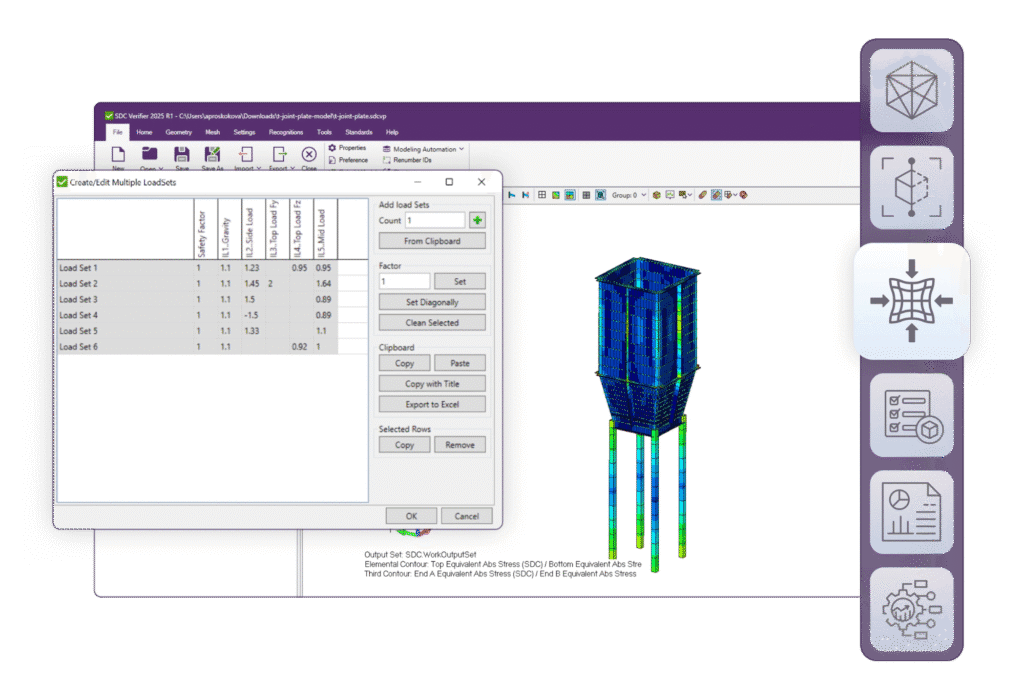Modern infrastructure projects generate unprecedented volumes of structural health data. A single suspension bridge can contain thousands of sensors, streaming stress, strain, vibration, and temperature data every second. Transmitting all of this to the cloud for processing is costly and slow. Research shows that hybrid cloud–edge computing can reduce bandwidth by over 70% and cut analysis latency by a third. For structural engineers it ensures compliance, prevents failure, and improves project ROI.
This is where Structural Analysis Software plays a pivotal role. By integrating advanced finite element analysis (FEA), automated code verification, and real-time monitoring, engineers can design, test, and maintain structures more effectively than ever before.
What Structural Analysis Software Delivers?

Structural Analysis Software provides engineers with tools to model and evaluate how structures behave under loads, including static, dynamic, fatigue, and buckling conditions. Key capabilities include:
- Load modeling: Wind, seismic, thermal, wave, and traffic loads.
- Component recognition: Beams, plates, welds, stiffeners, and joints.
- Standards compliance: Automated checks against Eurocode, AISC, ABS, API, ISO, and other design codes.
- Optimization and reporting: Parameter studies, sensitivity analysis, and auto-generated technical reports.
For infrastructure projects—bridges, offshore platforms, tunnels, wind turbines—the ability to simulate scenarios before failure occurs is essential. In the cloud–edge era, these simulations and verifications can happen both in design and during real-time operation.
Cloud vs Edge in Structural Engineering
The engineering challenge is not just creating FEA models but processing real-world data streams. The distinction is clear:
- Cloud computing: Ideal for large FEA models, historical analysis, and collaboration. Offers virtually unlimited compute resources.
- Edge computing: Processes sensor data near the source. Ideal for anomaly detection, threshold checks, and local decision-making.
- Hybrid architectures: Heavy FEA runs in the cloud, while edge devices filter raw sensor data, trigger alerts, and feed summarized results upstream.
For engineers, this means design verification can be performed centrally, while monitoring systems provide immediate insight on-site. This hybrid workflow enables faster iterations and safer operations.
Case Studies: Structural Analysis Software in Practice
- Bridge Load Capacity Evaluation
Engineers used structural analysis software to assess the load-bearing capacity of a highway bridge, identifying overstressed members and optimizing reinforcement strategies to extend its service life. - Dam Structural Integrity
Structural analysis software was used to perform finite element analysis on a concrete gravity dam, evaluating stress distribution under hydrostatic and seismic loads to guide maintenance planning. - Offshore Converter Platform
Structural analysis software SDC Verifier automated strength verification against offshore standards, reducing verification time by 50% compared to manual calculations and ensuring reliable performance under marine load conditions.
SDC Verifier: Automating Structural Verification

SDC Verifier is Structural Analysis Software designed to automate verification of FE models against global design standards. It integrates with tools like Ansys, Simcenter 3D, and Femap, or runs standalone.
Engineering Features
- Code libraries: Built-in support for Eurocode, AISC, ABS, API, DNV, ISO, and custom rule creation.
- Automatic part recognition: Identifies beams, plates, welds, and joints directly from FE models.
- Optimization: Plate thickness, weld sizes, or cross-section adjustments can be iteratively analyzed.
- Automated reporting: Standardized, updateable engineering reports ensure compliance documentation is accurate and traceable.
Fit with Cloud–Edge Workflows
- Design phase: Cloud resources run large FEA simulations, SDC Verifier automates the compliance check.
- Monitoring phase: Edge data streams (stress/strain) can be integrated into verification workflows, ensuring that operational loads remain within safe limits.
- Collaboration: Centralized model updates combined with auto-generated compliance reports accelerate approval cycles.
Engineering Challenges
- Edge compute limits: Full FE models are impractical at the edge. Only reduced-order models or filtered data should run locally.
- Data calibration: Sensor drift and synchronization errors can skew results; engineers must implement robust calibration protocols.
- Interoperability: Multiple formats and solvers require strong import/export capabilities.
- Security: Both hardware and cloud must meet data integrity and cybersecurity standards.
- Maintenance: Edge hardware in offshore or remote sites requires reliable power and environmental protection.
Best Practices for Engineers
- Use hybrid workflows: Cloud for heavy FEA, edge for anomaly detection.
- Keep code libraries updated: Ensure compliance with the latest Eurocode or API revisions.
- Apply digital twins: Pair real-time edge data with validated FE models for predictive maintenance.
- Automate reporting: Use software like SDC Verifier to reduce manual errors and ensure auditability.
- Plan for fail-safes: Define how systems respond if edge devices or cloud connectivity fail.
Future Trends in Structural Analysis
- AI-driven anomaly detection: Automated classification of cracks, fatigue, or load anomalies.
- Digital twins at scale: Entire infrastructure assets continuously mirrored in the cloud.
- Stronger edge devices: Enabling more complex model reduction techniques to run locally.
- Increased regulatory demand: More jurisdictions will require automated compliance checks and monitoring systems.
Conclusion
For structural engineers, the transition from cloud-only workflows to hybrid cloud–edge approaches represents a fundamental shift. Structural Analysis Software, particularly software like SDC Verifier, enables faster simulations, automated compliance, and reliable monitoring across the project lifecycle. The result is improved safety, reduced lifecycle costs, and greater engineering confidence in the face of growing infrastructure demands.





